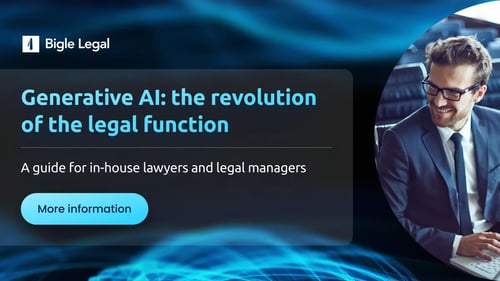Legal prompting: how AI transforms legal practice for lawyers
Have you heard of legal prompting? If you want to use artificial intelligence (AI) to optimise your daily work, read on, this concept will interest you. AI revolutionises the way we manage a multitude of legal tasks, but we must learn to communicate with it and ask it the right questions to extract 100% of its capabilities. In this sense, legal prompting is key for one simple reason: it is your key to communicating with AI so that it can draft documents, answer complex legal queries or translate legal texts in a matter of seconds. In this article, we'll show you how to use legal prompting to integrate this agility into your routine, freeing up your time to focus on higher-value strategies. Stay tuned and find out how to stay ahead of the curve in the dynamic world of AI.
In this article you will find:
- Generic generative AI vs. legal AI
- What is legal prompting?
- How to craft your prompts
- Key considerations when drafting your prompts
- 5 examples of legal prompting
- Jump into the future thanks to legal prompting
Generic generative AI vs. legal AI
The difference between a generic generative AI and one with specific training for the legal sector is crucial to understanding its application in the legal domain. Generic generative AIs, such as GPT-4, are trained on vast datasets from diverse sources and domains, allowing them to generate coherent and relevant text on a wide range of topics.
On the other hand, legal AIs are specifically trained on legal data, including case law, legislation and contractual documents. This specialised approach enables them to provide more accurate and contextually appropriate answers in the legal domain, facilitating tasks such as contract review, legal research and drafting legal documents with a high degree of accuracy. Thus, while generic generative AIs can be useful for general tasks, legal AIs provide the rigour and specificity required by legal professionals.
What is legal prompting?
Legal prompting is a technique used to effectively interact with generative AI systems in the legal field. It consists of formulating clear and specific questions or instructions that guide the AI to obtain accurate and useful answers.
A prompt is an instruction or input provided to an AI system to generate a response or perform a specific task. In the context of generative AI, such as that used in legal applications, a prompt is the question, statement or command given to the AI to produce relevant content. For example, a lawyer might use a prompt to ask the AI to draft a contract clause, translate a legal document or provide an analysis of a legal case. But be careful, because not everything goes: the effectiveness of the AI's response depends to a large extent on the clarity and precision of the prompt provided.
Thus, legal prompting is the fundamental technique for maximising the usefulness of AI in legal tasks, from drafting contractual clauses to translating documents and resolving complex legal queries.
You may be interested in: Guide to optimise your legal prompts for generative AI
How to craft your prompts
Achieving a complete and effective prompt can be complex, which is why it is necessary to follow clear guidelines. Let's take a look at five key points you should keep in mind when crafting your prompts for generative AI in the legal field. Practice makes perfect, so let's get to work!
- Contextualising the problem: make sure you provide enough context about the specific problem or legal situation. This will help the AI to better understand the scenario and generate more relevant answers. For example, if you need to draft a contract clause, include details about the parties involved and the type of contract.
- Use appropriate technical language: use accurate and appropriate legal terminology in your prompts. Specificity in language helps the AI to better grasp the subtleties of the law and generate answers that are both relevant and accurate. Avoid vague and generic terms that can lead to incorrect interpretations.
- Clear formatting instructions: clearly indicate the format in which you need the answer. This may include the type of document (contract, report, letter), the desired structure (sections, paragraphs, numbering) and any other specific formatting details that are relevant to your task.
- Repetition and refinement of prompts: don't hesitate to repeat and refine your prompts to improve the quality of responses. Try different formulations and adjustments until you find the style and structure that generates the most useful responses. Continuous feedback and adjustment of prompts is essential to maximise the effectiveness of AI.
- Reference regulations and precedents: If your query is based on specific regulations or judicial precedents, include them in your prompt. Referencing specific laws, articles, or cases can help the AI focus on the correct legal framework and provide a response that is more aligned with applicable case law.
These key points will help you create effective prompts that make the most of the potential of generative AI, improving the accuracy and relevance of the answers to your legal needs.
Key considerations when drafting your prompts
1. Clarity and specificity in prompts
As mentioned above, to obtain accurate and useful results, it is essential that prompts are clear and specific. The more information and context provided, the better the AI will be able to generate relevant responses.
2. Understand the limitations of AI
While generative AI can be a powerful tool, it is crucial that lawyers understand its limitations. AI can provide information and draft documents, but the work of review and final judgment must always rest with a legal professional. There is no doubt that this technology is a great ally, but it must be given its place.
3. Ethics and confidentiality
It is vital to consider the ethical and confidentiality implications of using AI in legal contexts. Ensure that sensitive data is handled with the utmost security and in compliance with all privacy and data protection regulations.
4. Training and adaptation
As a lawyer, it is highly recommended that you are willing to learn and train in the use of this technology, to maximise its potential and stay competitive in a legal environment that is already undergoing constant evolution.
5 examples of legal prompting
Let's look at five examples of prompts that can help you to start streamlining your tasks with AI. You should bear in mind that if you opt for a specialised law firm that you choose for your legal department, you will get more targeted and personalised answers for your work.
1. Drafting of documents and contractual clauses.
Example:
- Prompt: "Draft a confidentiality clause for a technology services contract."
- Generative IA: "The parties agree that all confidential information exchanged under this contract will be treated with the highest level of confidentiality...".
2. Translation of legal documents
Example:
- Prompt: "Translate the following paragraph of a Spanish rental agreement into English."
- Generative IA: "The lessee undertakes to keep the property in a good state of repair and to carry out any necessary repairs..."
3. Legal and juridical queries
Example:
- Prompt: "Provides a legal analysis of the implications of a breach of a contract of sale."
- Generative IA: "Breach of a contract of sale may result in the termination of the contract and the obligation of the breaching party to compensate the injured party..."
4. Legal research
Example:
- Prompt: "Find and summarise key court precedents related to intellectual property rights infringement."
- Generative AI: "In the cases of 'Company X vs. Company Y' and 'Author A vs. Company B', the courts found that..."
5. Contract review and analysis
Example:
- Prompt: "Review this lease and highlight any clauses that may be potentially problematic."
- Generative IA: "Clause 4.2 on annual rent increase could be problematic due to its ambiguity in the terms of calculation..."
Jump into the future thanks to legal prompting
Integrating legal prompting and AI into your legal practice can be a real game changer. These tools not only streamline daily tasks but also significantly improve the accuracy and efficiency of your work. Imagine being able to spend less time on repetitive tasks and more time on the strategies that really make a difference. By learning how to create effective prompts, you can transform document drafting, legal translation and legal consultations into much more streamlined and accurate processes. Adopting these innovations is not just an option, but a necessity to stay ahead in the dynamic world of law. Take this opportunity to improve your professional performance and take your legal practice to the next level with the help of legal prompting - it's time to take that technological leap and see your efficiency soar!
 By
By





